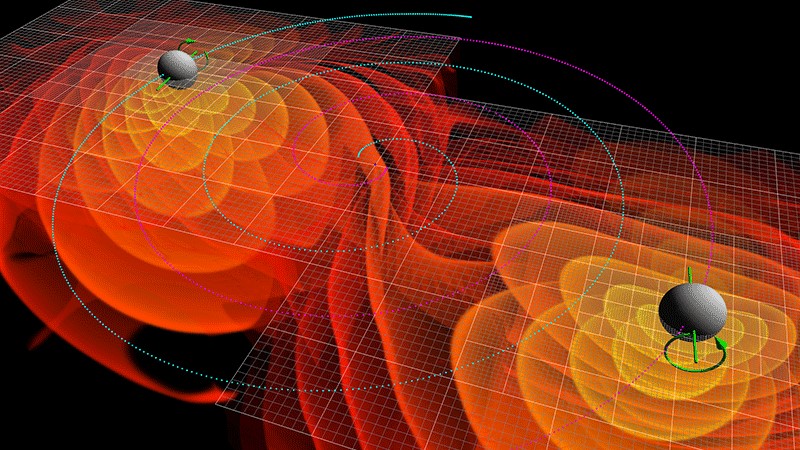'Tsunami' of gravitational waves sets record for most ever space-time ripples detected
The waves were produced by black holes and neutron stars spiraling into each other.

A record "tsunami" of gravitational waves — ripples in the fabric of space-time — could help to unlock the mysteries of how the universe and its stars evolved and put Einstein's theory of general relativity to the test.
Scientists working at the Laser Interferometer Gravitational-Wave Observatory (LIGO) in the U.S. and the Virgo interferometer in Italy detected a staggering 35 separate gravitational wave events between November 2019 and March 2020, more than a third of the total discovered to date. The researchers published their findings Nov. 5 to the preprint database arXiv, which means they have yet to be peer-reviewed.
Gravitational waves are the ripples created in the fabric of space-time when two extremely dense objects — such as neutron stars or black holes — get locked into a binary orbit around each other and eventually collide. These space-time ripples were first detected in 2015, but since then, scientists have been getting better at spotting the waves as they lap at our cosmic shores.
Related: 9 epic space discoveries you may have missed in 2020
"These discoveries represent a tenfold increase in the number of gravitational waves detected by LIGO and Virgo since they started observing," co-author Susan Scott, an astrophysicist at the Australian National University and a member of the international Advanced LIGO team, said in a statement. "This really is a new era for gravitational wave detections, and the growing population of discoveries is revealing so much information about the life and death of stars throughout the universe."
The LIGO and Virgo detectors spot gravitational waves by picking up the tiny distortions in the fabric of space they make as they pass through the detectors. The L-shaped detectors have two arms with two identical laser beams inside — each of the two LIGO detectors has 2.48-mile-long (4 kilometers) arms, and Virgo's arms measure 1.86 miles (3 km). If a gravitational wave passes through Earth, the laser in one arm of the detector is compressed and the other expands, alerting scientists to the wave's presence. But the tiny scale of these distortions — often the size of a few thousandths of a proton or neutron — means that the detectors have to be incredibly sensitive.
According to the scientists, 32 of the 35 new detections are from the merging of distant black holes. As the infinitely dense cores of the cosmic behemoths spiral into each other in ever faster and tighter loops, they eventually combine to form an even more massive black hole. The gravitational waves kicked up in the wake of these events, like the ripples formed in a pond after a stone is thrown in, can reveal a great deal about the black holes that made them.
Get the world’s most fascinating discoveries delivered straight to your inbox.
"Looking at the masses and spins of the black holes in these binary systems indicates how these systems got together in the first place," Scott said. "It also raises some really fascinating questions. For example, did the system originally form with two stars that went through their life cycles together and eventually became black holes? Or were the two black holes thrust together in a very dense dynamical environment, such as at the centre of a galaxy?"
The observations reveal a surprising diversity in black hole sizes throughout the universe. For instance, one black-hole pair was 145 times the mass of the sun, while another was only 18 times the sun's mass.
The other three wave detections are slightly more mysterious, possibly coming from the merger of the infinitely dense black holes with other, less dense, cosmic objects. It's likely that these second objects were neutron stars — the ultradense remnants of massive stars formed after enormous stellar explosions called supernovas, the astronomers said.
And these weirder signals may just be the first of many such signals to be detected. Improvements in the sensitivity of the detectors will allow scientists to pick up fainter signals from more unexpected sources. This could not only give them some unprecedented glimpses into the nature and evolution of gravitational wave making stars and stellar remnants in the universe but also allow researchers to devise new tests for the laws of gravity — set out by Albert Einstein's theory of general relativity — which describe the behavior of all massive objects.
"Our latest results prove that they [black holes] come in many sizes and combinations — we have solved some long-standing mysteries, but uncovered some new puzzles too," co-author Christopher Berry, an astronomer at the University of Glasgow in Scotland, said in a statement. "Using these observations, we are closer to unlocking the mysteries of how stars, the building blocks of our universe, evolve."
Originally published on Live Science.

Ben Turner is a U.K. based writer and editor at Live Science. He covers physics and astronomy, tech and climate change. He graduated from University College London with a degree in particle physics before training as a journalist. When he's not writing, Ben enjoys reading literature, playing the guitar and embarrassing himself with chess.


